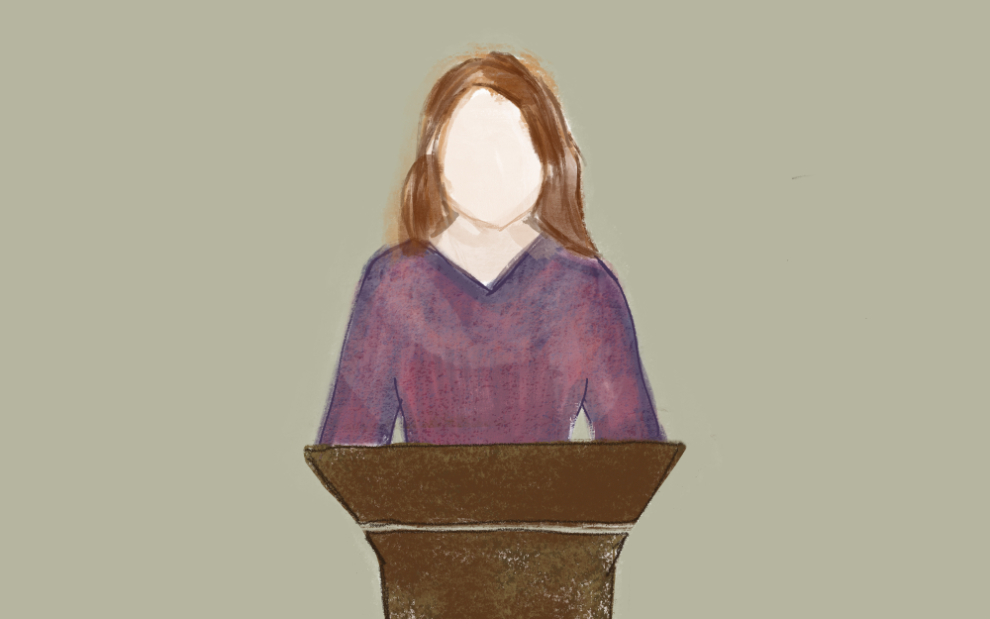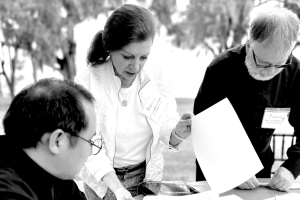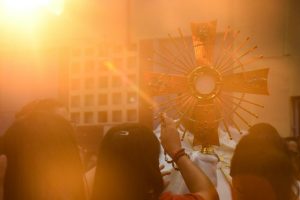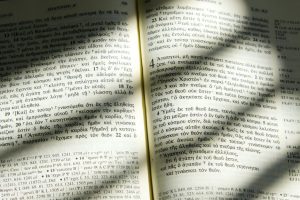In September 2023, five women who had made abuse allegations against Slovenian artist and former Jesuit Father Marko Rupnik publicized an open letter in response to the Vicariate of Rome’s positive report on the Centro Aletti, the art and theology school Rupnik founded. The women expressed their hurt and frustration, stating that they were left speechless by the report, which, they said, “ridicules the pain of the victims, but also of the whole Church, mortally wounded by such blatant hubris.” According to the women, Pope Francis never responded to letters from Rupnik’s victims.
Although Rupnik was excommunicated in 2020 and expelled from the Jesuit order in 2023, Pope Francis initially opted not to waive the statute of limitations for the women’s claims. Following the open letter and a general outcry over the handling of this case, in October 2023 the pope finally ordered the Vatican to remove the statute of limitations and go forward with a church trial. Rupnik had plenty of defenders, however, who reaffirmed the good he had done through his art while minimizing his actions and even accusing the women of seducing him.
These defenses echoed similar responses in the case of another accused priest, the late Father C. John McCloskey, a popular conservative writer affiliated with the Prelature of Opus Dei. Even after Opus Dei paid nearly a million dollars to McCloskey’s victim in 2005, the organization continued to allow McCloskey to meet with women and hear their confessions. Yet when news of the accusations and the payment emerged in 2019, many people responded by downplaying the priest’s culpability. Others sought to remind their audiences of the good works McCloskey had done and implied that his misconduct was consensual. Some people claimed that his victim was trying to get attention.
Both cases highlight what many people see as a reluctance to take accusations from women seriously. A 2004 John Jay report found that 4 out of 5 juvenile victims of clergy abuse were male, and the media has focused almost exclusively on these cases. Female victims, by contrast, are frequently ignored.
This trend of discounting female survivors points to a larger question, however, that transcends ideological divisions and relates to issues across the spectrum of church teachings and concerns. Namely, is the church really listening to women at all?
A change in the air
This past October, the much-anticipated first installment of the Synod on Synodality took place in the Vatican. A working document called Instrumentum Laboris—written by a committee of 22 members and meant to guide the discussions at this global assembly—contains two sections. The first half summarizes the findings of the earlier gatherings and offers a definition of synodality, while the second half consists of worksheets intended to guide the small group sessions that took place during the synod.
Pope Francis, in his address to synod participants, instructed them to listen to all baptized Catholics and respect their faith and particularly highlighted the need to listen to women, noting that the bishops and cardinals likely learned their faith from their own mothers. The pope stated that “it is women who know how to wait, who know how to discover the resources of the church, of the faithful people, who take risk beyond the limit, perhaps with fear but courageous.”
For Catholic women who continue to wonder how synodal a church can be as long as women are shut out of decision-making, these qualities of hope and risk-taking are essential to their work and activism.
A question of leadership
The first half of Instrumentum Laboris included discussion on the restoration of female deacons. Scholar Phyllis Zagano, who served on the 2016–2018 Papal Commission for the Study of the Diaconate of Women, wrote in the Tablet before the synodal gathering that “to argue against restoring women to the diaconate is to argue against diaconal ministry itself.”
Zagano reiterates that there is no question that women served as deacons from the early church until the 12th century. The first mention of a female deacon appears in scripture, when St. Paul discusses the deacon Phoebe in his letter to the Romans. He describes Phoebe’s role as equivalent to that of her male counterparts. Female deacons are thought to have served other women and assisted with the sacraments in many of the same ways that the current all-male diaconate does.
Opponents of women in the diaconate argue that women cannot be ordained, but Zagano disputes this with evidence that the Vatican Library itself contains rites of ordination to the diaconate for both men and women. “The women were ordained as deacons by their bishops within the sanctuary during Mass, in the presence of the clergy through the imposition of hands by the invocation of the Holy Spirit; they self-communicated from the chalice; the bishop placed the stole around their necks and, importantly, they were named deacons,” Zagano says. However, she also notes that the “diaconate is not the priesthood.”
Although the synod report is encouraging, the question of whether the church will restore the ordination of female deacons remains unanswered. The two sections on women in the diaconate received the highest number of negative votes by members of the synod. While the resulting report calls for more investigation, Zagano is frustrated. “Given that there have been at least four studies in modern times, including one with positive findings in 1997 that was not promulgated, the church may be becoming weary of what appears to be another postponement,” she says. “It seems an insurmountable task to get a general agreement on the facts of history, anthropology, and theology of the question such that the whole church would ask for the restoration of women to the ordained diaconate.”
Conversations about reproductive justice
Emily Reimer-Barry, assistant professor of theology and religious studies at the University of San Diego, says the question we should be asking is not whether the church is listening to women, but whether church hierarchy is. The church, after all, is the people, and over half those people are women. Nevertheless, Reimer-Barry says, these women are “excluded from participation in ordained ministries and most leadership structures.”
Reimer-Barry is currently working on a book about pragmatic solidarity and reproductive justice. She envisions a future where people can find common ground between Catholic social teachings and reproductive advocacy, recognizing that contraception access and abortion are complex issues that can’t be properly understood without awareness of the ways that social conditions affect individual decisions.
Reimer-Barry says, “When a woman faces an unplanned or ill-timed pregnancy, she is going to make a decision based on factors such as the health and stability of the intimate relationship and whether she can reasonably see coparenting with her partner as a possibility; her financial stability and whether she can afford to raise a(nother) child; her health and the degree of risk she would undertake in continuing a pregnancy; the safety of her neighborhood; the strength of the local schools; whether she can afford to feed her family; the stability of her housing; and more.”
One way the church could foster better understanding of reproductive justice, Reimer-Barry says, is for seminary curriculum to include accurate information about women’s embodied experiences. In addition, Reimer-Barry says that true reproductive justice centers the voices of women of color and poor women. “Scholars of reproductive justice focus on these groups in particular because of the legacy of state-sanctioned violence against women, including enslavement, coerced sterilization, and family separation policies—all of which have been legal in U.S. history at various points in time,” she says.
Women on the margins
For Stephanie Battaglino, just being a Catholic is an act of resistance. Battaglino is transgender, and for a while following her transition, she worshipped outside the Catholic Church. “I thought, no way in hell I’m going to go back to my parish as my authentic self. But where could I go?” Battaglino says. “And what Catholic parish is going to accept me? This was around 2003, and there were some accepting places, but they were far away and still kept us in the basement, away from other worshippers. So a friend of mine who was also transitioning asked if I wanted to go to an Episcopal church nearby, where their motto was radical hospitality. That became my home for a long time.”
A chance meeting with Sister Luisa Derouen, who ministers to transgender Catholics, initiated a return to Catholicism for Battaglino. “I went on retreat with Sister Luisa, and it was then I realized through her friendship that the Catholic Church was open to me,” Battaglino says. “She’s been my spiritual director ever since.”
Having spent most of her adult life as male-presenting, Battaglino has a unique perspective on the difference in how the church treats men and women. For example, while Battaglino obtained an annulment for her first marriage, the second was never annulled, and she continued to be an active member of her parish while in a third marriage as a lector and a leader in the local Knights of Columbus chapter. “I was never questioned about anything as a straight Catholic white guy,” she says.
Since transitioning, finding a Catholic parish home has proven difficult, although Battaglino credits Derouen for encouraging her to claim her place in the church. “If you’re a cisgender person who wants to worship, all you have to do is go online, find a parish, and pick one based on drive times,” Battaglino says. “And if you don’t gel with that parish, you can pick the next one on the list. But it doesn’t work like that for transgender people, where there is a much deeper decision set.”
Battaglino is encouraged by Pope Francis and believes he is open to change, but she wants to know whether the church has a plan for greater inclusivity. “You say you want to be open to a greater role for women in the church, but what does that mean?” she says. “What’s the plan of action? Is there one? Where is the tangible plan to get us from where we are now to where we would like to be?”
Intersectional concerns
For writer and speaker Leslye Colvin, finding her voice in the wake of the murders of George Floyd, Ahmaud Arbery, and Breonna Taylor led to using her words as a prayer. “I felt something that I hadn’t felt since my childhood in the 1960s in Alabama as a little girl in a Black body,” she says. “I found it life-giving to speak in particular to matters that come from white body supremacy. And I know that the church needs to hear what I have to say.”
Colvin’s own writing is inspired by other Black women. Her perspective informs her reflections and the overlap between the treatment of various groups of marginalized people. In her essay “Why I Speak on Race” Colvin writes, “When you first recognize a single lie of oppression or injustice, compassion, curiosity, and courage, will, in time, compel you to question other accepted beliefs.”
Historian Shannen Dee Williams points out the historical influence of Black Catholic women, even if they remain “hidden figures” in the history of the fight for freedom and justice in the United States. In an article for the Washington Post, Williams writes that “Black women and girls are some of [the nation’s] most formidable prophets of democracy and Catholicism—if only [the church will] dare to listen.”
Active representation
Many in the church hierarchy seem hesitant about the summons to listen. Rhonda Miska, a member of the advisory board for Catholic Women Preach, attended the Synod on Synodality as part of the Discerning Deacons delegation. Miska feels hopeful that the conversation is ongoing but notes that much disagreement stems from a misunderstanding of the role of the female diaconate. “I think some of the resistance to reinstating the diaconate for women is that there is a ‘slippery slope’ and it will lead to a greater push for women’s ordination to the priesthood,” Miska says. “But the priesthood and diaconate are two very different roles, and those are two entirely separate conversations.”
Miska would like to see more opportunities for women to preach at vespers, word and communion services, and even at Mass, within the bounds of what is permitted in each diocese. “There are so many women who are called and gifted, and there are so many people in the pews who could hear and receive the Word of God in a new and fresh way if it were preached by women,” she says.
For Emily Kahm, associate professor of theology at College of Saint Mary in Omaha, Nebraska, merely being represented in church leadership is insufficient. “Representation should be the baseline, not the ultimate goal,” she says. “And until representation is established, other goals are not likely to happen. Even if women are in line with all of the teachings of the church, you would still see a massive change within the church with full representation, because women’s lives are just different.”
Kahm points out that the church offers seven sacraments but only six are available to women. And church leaders, who are all men, aren’t used to being secondary to a conversation. “I’d love to see women speaking to one another and men only there to listen, because men haven’t always thought of the gendered dynamics of how women are rewarded for being quiet,” Kahm says. “It’s critically important for men to put themselves in spaces where they are not the center. Otherwise, where do you get the solidarity?”
“God listened to a woman”
Father Stephanos Pedrano has dedicated his life to the church as a Benedictine monk. While he resides in predominantly male spaces, Pedrano has spent time reflecting on the importance of women within the church. He says, “At Nazareth, God listened to a woman, and a woman listened to God. That’s where Christ and Christianity began. Mary the mother of Jesus was the first evangelist.”
Throughout Jesus’ life and ministry, and even after the resurrection, the mission of the church has been rooted in Mary’s “yes,” Pedrano reminds Catholics. “Until the final fulfillment of world history, that woman’s experience, that Marian event at Nazareth, is the ongoing roadmap of all sacraments, liturgy, and authentic life in the church: the initiative of God in offering the gospel but waiting and listening for human consent, the consent of human coworkers,” Pedrano says.
Colvin has also spent time reflecting on the feminine nature of the church. “I find it interesting that we speak of the church as being female, but does she listen to women?” she asks. “Because based on that, it would seem inevitable that the church listens to women, but we know that is not generally the case.”
Colvin reminds us that Jesus himself listened to both his own mother and other women. “I think about Jesus listening to Mary Magdalene, apostle to the apostles, and the tension that he would have observed in others by listening to her,” she says. “Jesus engaged in conversation at the well with the Samaritan woman, asking her questions, and prompting her to speak to him in response, but mostly I return to Our Lady because the image we currently have does not embrace the strength of her character that would have allowed her to say ‘yes’ at the annunciation.”
Recognizing that mothers are the first teachers of the faith to their children, before they move into the institutional church where only men are preaching, caused Colvin to reflect on the ways in which the church views women and why. “It’s from our history of condemning Eve, the ways in which women were in danger for being pregnant out of wedlock, even Our Lady’s life was in danger,” she says. “The woman is judged and not recognized for the gifts she brings. It’s mind-boggling that some of these same arguments continue 2,000 years after what Jesus taught and embraced.”
Whether or not the ongoing synod will be a step toward greater representation of women in the life of the church remains to be seen. As Miska notes, synodality should be about trusting that everyone in the church has things to teach and things to learn. She says, “If we embrace Pope Francis’ invitation to parrhesia (bold speech) and say, ‘I am a woman and I think I might be called to be a deacon, or called to preach,’ among ourselves, that matters.”
For these and many other women, full participation seems a distant if not impossible reality given that even historical roles such as the female diaconate are discouraged for fear of giving women too much power, as both Zagano’s and Miska’s experiences confirm. And as Colvin points out, until the church hierarchy returns to the foundational principle of Jesus whose very incarnation relied on the “yes” of Mary, women will continue to express frustration at being left out of the conversation.
This article also appears in the February 2024 issue of U.S. Catholic (Vol. 89, No. 2, pages 31-35). Click here to subscribe to the magazine.
Image: iStock












Add comment